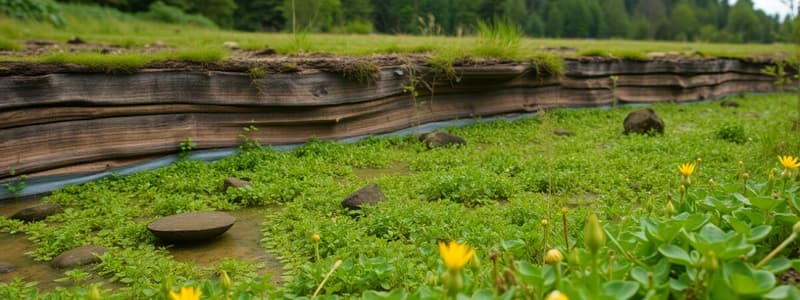Podcast
Questions and Answers
¿Cuál de los siguientes procesos convierte el nitrógeno atmosférico en una forma utilizable por las plantas?
¿Cuál de los siguientes procesos convierte el nitrógeno atmosférico en una forma utilizable por las plantas?
- Fijación de nitrógeno (correct)
- Amonificación
- Desnitrificación
- Asimilación
¿Qué rol desempeñan los descomponedores en el ciclo del fósforo?
¿Qué rol desempeñan los descomponedores en el ciclo del fósforo?
- Convierten el fosfato en nitratos.
- Liberan el fosfato de la materia orgánica muerta de vuelta al suelo. (correct)
- Fijan el fósforo en rocas sedimentarias.
- Absorben el fósforo directamente de la atmósfera.
¿Cuál de las siguientes opciones representa mejor la importancia de los ciclos biogeoquímicos?
¿Cuál de las siguientes opciones representa mejor la importancia de los ciclos biogeoquímicos?
- Aumentan la variabilidad climática global.
- Reducen la disponibilidad de nutrientes esenciales.
- Aceleran la erosión del suelo.
- Mantienen el equilibrio de los elementos dentro del sistema terrestre y sustentan la vida. (correct)
¿Qué proceso del ciclo del nitrógeno devuelve el nitrógeno a la atmósfera?
¿Qué proceso del ciclo del nitrógeno devuelve el nitrógeno a la atmósfera?
¿Cuál de los siguientes elementos es esencial para la creación de ADN, ARN y ATP?
¿Cuál de los siguientes elementos es esencial para la creación de ADN, ARN y ATP?
¿Cuál de los siguientes procesos no contribuye directamente al movimiento del agua desde la superficie terrestre a la atmósfera en el ciclo del agua?
¿Cuál de los siguientes procesos no contribuye directamente al movimiento del agua desde la superficie terrestre a la atmósfera en el ciclo del agua?
¿Qué ocurre con el dióxido de carbono absorbido por los océanos?
¿Qué ocurre con el dióxido de carbono absorbido por los océanos?
¿Cuál de las siguientes opciones describe mejor un 'reservorio' en el contexto de los ciclos biogeoquímicos?
¿Cuál de las siguientes opciones describe mejor un 'reservorio' en el contexto de los ciclos biogeoquímicos?
¿Cuál de estos procesos libera carbono almacenado en combustibles fósiles a la atmósfera?
¿Cuál de estos procesos libera carbono almacenado en combustibles fósiles a la atmósfera?
Si el tiempo de ciclo de un elemento en un ecosistema disminuye dramáticamente, ¿qué implicación podría tener esto para la disponibilidad de ese nutriente?
Si el tiempo de ciclo de un elemento en un ecosistema disminuye dramáticamente, ¿qué implicación podría tener esto para la disponibilidad de ese nutriente?
¿Cuál de las siguientes afirmaciones describe mejor el papel de la fotosíntesis en el ciclo del carbono?
¿Cuál de las siguientes afirmaciones describe mejor el papel de la fotosíntesis en el ciclo del carbono?
¿Qué proceso convierte por lo general el carbono orgánico muerto en carbono inorgánico?
¿Qué proceso convierte por lo general el carbono orgánico muerto en carbono inorgánico?
¿En qué se diferencia el ciclo del agua de los ciclos del carbono y otros ciclos biogeoquímicos?
¿En qué se diferencia el ciclo del agua de los ciclos del carbono y otros ciclos biogeoquímicos?
Flashcards
Ciclo del nitrógeno
Ciclo del nitrógeno
Circulación del nitrógeno en aire, suelo y organismos vivos.
Fijación de nitrógeno
Fijación de nitrógeno
Bacterias convierten nitrógeno atmosférico en formas utilizables para las plantas.
Ciclo del fósforo
Ciclo del fósforo
Ciclo terrestre que incluye la absorción de fosfato por plantas.
Asimilación
Asimilación
Signup and view all the flashcards
Importancia de los ciclos biogeoquímicos
Importancia de los ciclos biogeoquímicos
Signup and view all the flashcards
Ciclos biogeoquímicos
Ciclos biogeoquímicos
Signup and view all the flashcards
Reservorios
Reservorios
Signup and view all the flashcards
Flujos
Flujos
Signup and view all the flashcards
Tiempo de ciclo
Tiempo de ciclo
Signup and view all the flashcards
Ciclo del agua
Ciclo del agua
Signup and view all the flashcards
Fotosíntesis
Fotosíntesis
Signup and view all the flashcards
Decomposición
Decomposición
Signup and view all the flashcards
Captura oceánica
Captura oceánica
Signup and view all the flashcards
Study Notes
Introduction to Biogeochemical Cycles
- Biogeochemical cycles are the pathways by which essential elements and compounds circulate between living organisms (biosphere) and the non-living environment (lithosphere, atmosphere, hydrosphere).
- These cycles are crucial for life on Earth, as they continuously recycle vital nutrients.
- They are essential for maintaining the balance of elements in the Earth's systems.
Key Concepts
- Reservoirs: Locations where elements are stored in the biogeochemical cycle. These can include the atmosphere, oceans, soil, and living organisms.
- Fluxes: The movement of elements between reservoirs. These movements can be through processes like photosynthesis, decomposition, or weathering.
- Cycling time: The time taken for an element to complete its full cycle from one reservoir to another and back. This can vary significantly for different cycles.
- Nutrient Availability: The availability of nutrients in various forms influences the growth and survival of living things.
The Water Cycle
- The hydrologic cycle, or water cycle, describes the continuous movement of water on, above, and below the surface of the Earth.
- Evaporation: Water from bodies of water changes into a gas (water vapor).
- Condensation: Water vapor cools and changes back into liquid water, forming clouds.
- Precipitation: Water falls from the clouds as rain, snow, sleet, or hail.
- Collection: Water collects in rivers, lakes, oceans, and groundwater.
- Transpiration: Water evaporates from plants.
- The cycle is crucial for regulating Earth's temperature and supporting life, transporting nutrients, dissolving and removing pollutants, and maintaining appropriate habitats for various organisms.
The Carbon Cycle
- The carbon cycle describes the movement of carbon throughout the Earth's systems.
- Photosynthesis: Plants absorb carbon dioxide from the atmosphere and use it to build sugars.
- Respiration: Organisms release carbon dioxide back into the atmosphere as by-products of cellular respiration.
- Decomposition: Decomposers break down dead organisms, releasing carbon dioxide into the atmosphere, or returning carbon to the soil.
- Fossil Fuels: Carbon stored underground for millions of years as fossil fuels is released into the atmosphere when burned.
- Ocean Uptake: Oceans absorb carbon dioxide from the atmosphere.
The Nitrogen Cycle
- The nitrogen cycle describes the circulation of nitrogen through the air, soil, and living organisms.
- Nitrogen Fixation: Certain bacteria convert atmospheric nitrogen into usable forms for plants.
- Nitrification: Other bacteria convert ammonia into nitrites and nitrates, usable by plants.
- Assimilation: Plants absorb nitrates and use them in their growth processes.
- Ammonification: Decomposers convert organic nitrogen to ammonia.
- Denitrification: Certain bacteria convert nitrates back into atmospheric nitrogen.
- Nitrogen is an essential element for proteins and nucleic acids, making this cycle vital for life.
The Phosphorus Cycle
- The phosphorus cycle is largely a terrestrial and sedimentary cycle.
- Weathering of rocks: Releases phosphate into the soil.
- Plant uptake: Plants absorb phosphate from the soil for growth and development.
- Animal consumption: Animals consume plants and other animals that contain phosphorus.
- Decomposition: Decomposers release phosphate back into the soil.
- Sedimentation: Phosphate from bodies of water becomes deposited on the ocean floor and can eventually become rocks.
- Phosphorus is essential for creating DNA, RNA, and ATP. It is important for plant and animal growth.
Importance of Biogeochemical Cycles
- These cycles are essential for maintaining the balance of elements within Earth's system. Disruptions to these cycles can bring about disastrous impacts to our planet.
- The cycles help regulate Earth's temperature, maintain the availability of essential nutrients, and support life.
Studying That Suits You
Use AI to generate personalized quizzes and flashcards to suit your learning preferences.




